Science and Math Project-Based Learning: Finding Balance of Content Standards, Disciplinary Practices, and Elements of Project-Based Learning
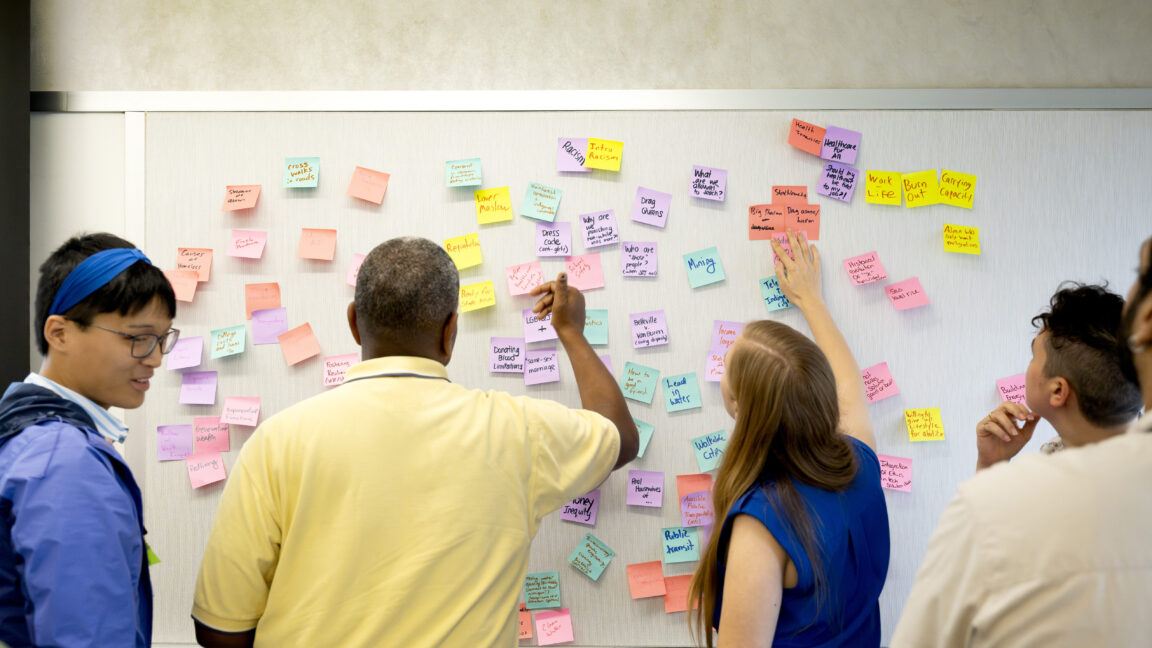
As early-career math and science educators, we sought to establish classrooms that not only adhered to the then-new education standards, but also fostered profound conceptual understanding and skills in scientific and mathematical thinking among all students. Our approach involved engaging students in meaningful performance tasks, supported by Common Core State Standards (CCSS; National Governors Association, 2010) and the Next Generation Science Standards (NGSS; National Research Council, 2013). Bringing this vision to life necessitated significant changes in both curriculum materials and instructional practices, addressing both “what students learn” and “how students learn.” Achieving deep alignment with these standards meant more than just covering individual components; it entailed designing learning experiences and tasks that seamlessly integrated components to promote coherent, rigorous, and profound learning. As we began to undertake this complex and challenging work, we each realized certain pedagogical approaches seemed better positioned to engage students in complex tasks and provided a coherent framework for us as we were looking to transform our practice. Separately, we all found ourselves using Project-Based Learning (PBL). In this article, we define PBL, share a framework we developed to plan PBL projects, and provide an example of the framework in practice from one of our classrooms.
We noticed many of the planning resources and professional learning offerings left math and science teachers to envision on their own
PBL is an instructional method “in which students learn by actively engaging in real-world and personally meaningful projects” (What Is PBL?, n.d.). Research on PBL in math and science suggests that this approach can support students’ content knowledge acquisition, process skill development, ability to apply skills and knowledge in new situations, and ability to draw connections between concepts—all goals underlying the design of new math and science standards (Kingston, 2018). As we each began to engage in PBL in our classrooms, we noticed many of the planning resources and professional learning offerings left math and science teachers to envision on their own how this model could effectively support their existing disciplinary goals. In the case of math, this lack of support reinforces the pervasive misperception that PBL cannot work in mathematics. In our experience, math teachers were often told to consider Problem-Based Learning—a pedagogy similar to PBL but with a more limited scope and time frame—instead, on the premise that math cannot be learned through the situated real-world tasks that characterize PBL (Larmer, 2015). Furthermore, when there were professional resources related to PBL in math and science, they often described introductory ideas about PBL but fell short of illustrating how the model can be designed to do the heavy lifting of a curriculum, pushing students to build deeper understandings within standards-aligned learning goals.
In our collaboration through the Knowles Teacher Initiative, the four of us came together to engage in discussions about our encounters with PBL. Our experiences span large comprehensive public schools where only a few teachers used PBL and small public charter schools where all the teachers used PBL. Throughout these conversations, we shared our perspectives on how PBL can serve as a potent catalyst for fostering equitable and discipline-rich learning in math and science. Simultaneously, we unanimously held the belief that achieving these equitable and discipline-rich experiences wasn’t a matter of chance. Each of us had numerous anecdotes about PBL projects that didn’t quite meet expectations, but we also had stories where PBL projects resulted in exceptionally positive learning experiences for our students.
Upon examining our projects that fell short, we identified two distinct categories. The first type, referred to as a “dessert project,” mirrors a common occurrence in many classrooms. In these projects, the primary focus is on the content, which is taught sequentially, with the project serving as a culminating activity (“Doing a Project” vs. Project Based Learning, n.d.). Despite being more prevalent in non-PBL classrooms, we discovered that even when deliberately practicing PBL, dessert projects could still emerge. An initial challenge we, along with many other PBL educators, faced was launching the project and succumbing to the pressure to quickly cover a significant amount of content. This often resulted in students revisiting the context of the project at the end of the unit, expressing sentiments like, “Ohhhh yeah, we’re still doing that project.” The second type of project we observed is what we term a “product-driven project.” In these projects, students exhibit high engagement with the project’s context and the creation of the final product. However, as instructors, we reached the project’s conclusion only to realize that students had overlooked key math and science standards. Additionally, we dug into successful projects where we found our students engaging deeply with the math and science content and practice standards producing real-world authentic end products. Through comparing these successes and shortcomings we established a planning framework which brings together the components of our successful projects.
Introduction to the Project Planning Framework
The PBL Planning Pyramid: A Framework to Ensure Discipline-Rich Math & Science Projects (Figure 1) is a lens through which one can intentionally plan PBL projects by not only attending to the elements of PBL but also intentionally weaving the content standards and disciplinary practices (and scaffolding) throughout the project.
Figure 1
PBL Planning Pyramid: A Framework to Ensure Discipline-Rich Math & Science Projects
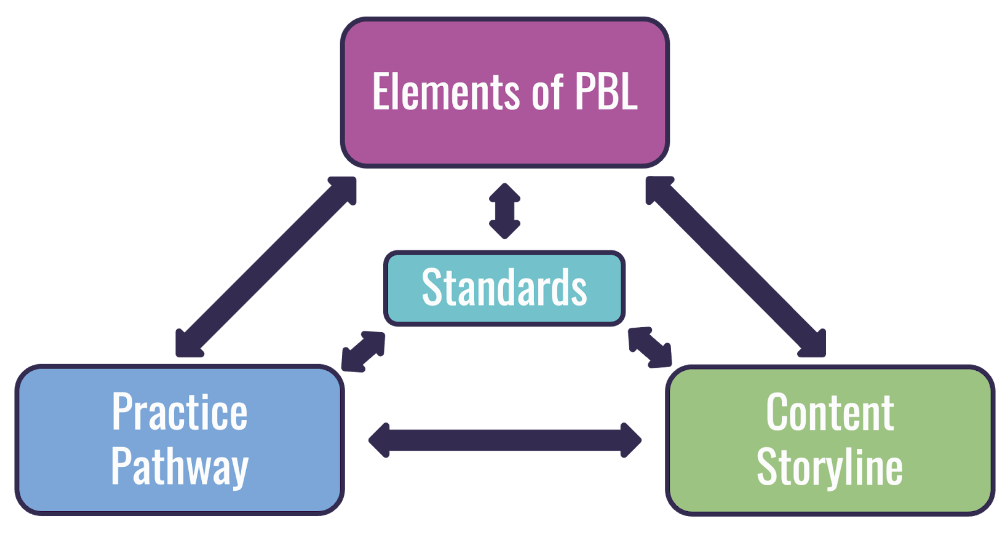
Elements of PBL
Building on conceptualizations from PBLworks (Gold Standard PBL, n.d.), Edutopia (Miller, 2017), and our own experiences as PBL teachers, we consider the elements of PBL to be the following things: checkpoints, entry events, knows and need to knows, inquiry, scaffolding and assessment, student voice, rubrics, end product and presentation, and focus statement (Figure 2).
Figure 2
Elements of PBL
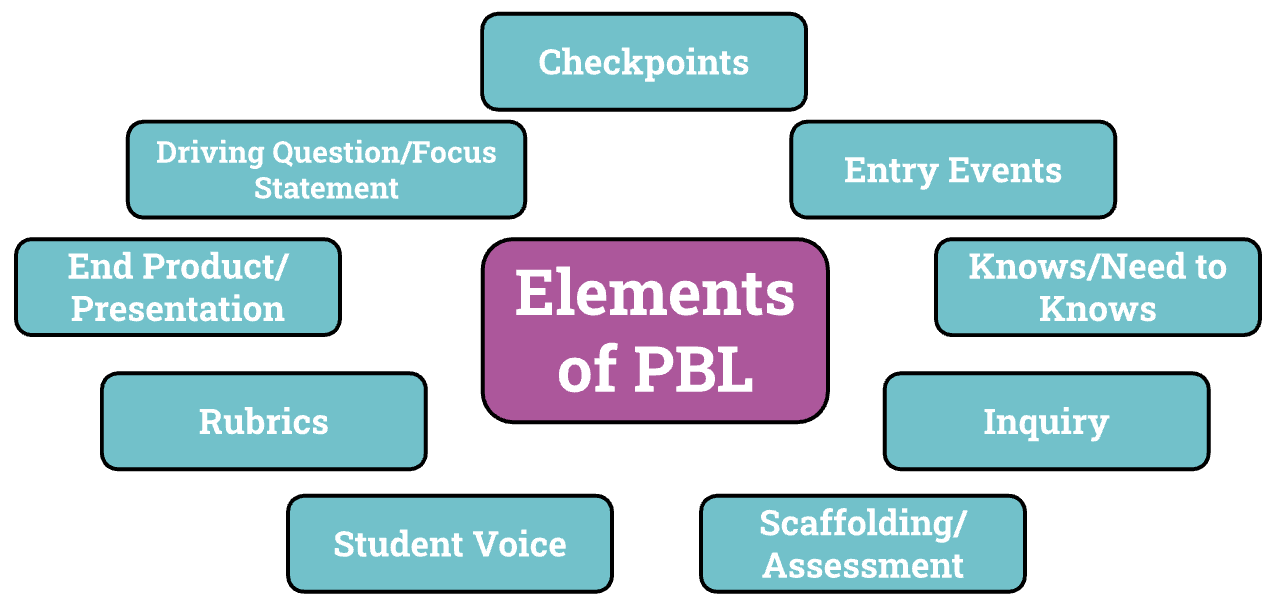
A common misconception is that the elements of PBL are removed from the standards being taught in the classroom; however, that is not the case. Each of the elements are driven by and selected from the standards. For instance, the final product is selected based on what is authentic for that specific set of standards. If the standards are about human impacts on Earth systems, global climate change, and weather and climate, it may not make sense to have students create scale models. However, it would make sense to develop a project that has students researching climate change impacts and using that understanding to create an awareness campaign for the impact on local communities.
Content Storyline
Although grounding the elements of PBL in the standards is a critical first step, this is not enough to ensure students won’t lose sight of the important content. To do this, the content standards need to be developed across the span of the project which involves engaging in the practice of creating a content storyline.
A common misconception is that the elements of PBL are removed from the standards being taught in the classroom; however, that is not the case.
The concept of content stories and storylining has held a more prominent place in discussion among the science education community (Nordine et al., 2019). In particular, with the uptake and shift toward NGSS (National Research Council, 2013), the use of content stories has been increasingly leveraged to support implementation. A content storyline provides “a coherent path toward building disciplinary core ideas and crosscutting concepts, piece by piece, anchored in students’ own questions” (What Are Storylines?, n.d.). As a key consideration, content storylines are not the same as lesson plans, as they are meant to build transparency and coherence from both the students’ and teacher’s perspectives (What Are Storylines?, n.d.).
We think this framing can be a particularly powerful tool to support in the design of discipline-rich PBL projects. As we see it pertaining to the PBL Planning Pyramid, the core question to ask yourself when considering a Content Storyline is: What should students be able to figure out or explain once they have mastered the standards in this project? (Figure 3). This tool is important because it allows both:
- students to construct content understandings as a story to help them organize and transfer their content learning from the project to new situations, and
- supports educators in determining what content ideas are prioritized when planning for a discipline-rich project.
For a content storyline to be utilized to its greatest potential in PBL planning, it is vital to spiral learning opportunities that directly link the day’s learning to the end product of the project. This provides a unified scope of learning that progresses from the beginning of the project to the end product completion.
Figure 3
Questions to consider when using the PBL Project Planning Framework
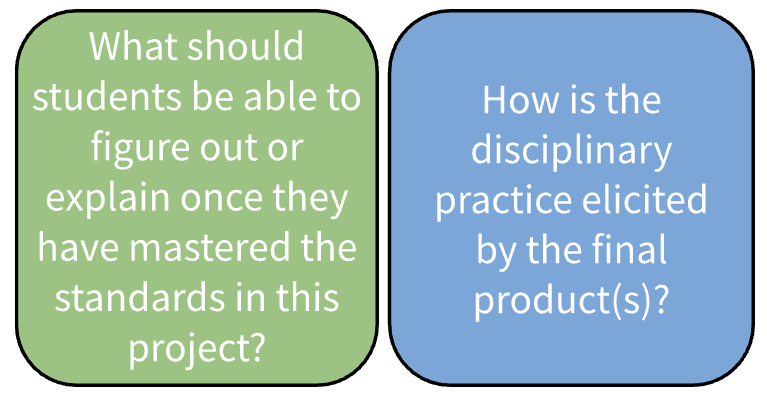
Practice Pathway
Similarly, we found that our most successful projects intentionally supported growth in the disciplinary practices in our students. This was done by selecting one practice and intentionally scaffolding the practice throughout the project. We developed the concept of the practice pathway to accompany the content storyline as a way to intentionally scaffold, with a focus on the mathematical practices (National Governors Association, 2010) or science and engineering practices (National Research Council, 2013). A practice pathway builds out regular opportunities for a student to gain skill in a practice, which is often not a focus in classic lesson planning. We recognize that in a given PBL project, students will employ multiple practices and skills; however, a practice pathway narrows the focus to a single, aligned practice to assess and develop over the course of learning.
As we see practice pathways pertaining to the PBL Planning Pyramid, the core question to ask yourself is: How is the disciplinary practice elicited by the final product(s)? (Figure 3). This tool is important because it engages students in meaningful skill development and positions this learning as powerful and necessary for science and math learners alongside the content. For a practice pathway to be actualized in PBL planning, it is essential to provide multiple opportunities for students to engage in feedback cycles and assessments around the selected practice. This provides a unified scope of learning that progresses from the beginning of the project to the end product completion.
The Field Trip Project: Project Planning Framework in Practice
Rooted in these standards, the content storyline and practice pathways emerge and are woven together to craft a discipline-rich experience for the students.
To support teachers in visualizing how these three components work together to develop a discipline-rich project, we provide an example of a mathematics project. This project, titled The Field Trip Project, was developed by Sarah DiMaria and implemented in her 9th grade Algebra 1 course at a small public charter school focused on using PBL in their classrooms.This four-week project was one of the first projects of the year covering the Polynomials and Linear Relationships Unit of the curriculum. Since this project was early in the year, Sarah deeply scaffolded the mathematical practice of attending to precision. In this project, she asked students to practice communicating precisely to an audience while accurately and efficiently calculating expenses for a school field trip. Rooted in these standards, the content storyline and practice pathways emerge and are woven together to craft a discipline-rich experience for the students.
Elements of PBL in the Field Trip Project
As discussed above, many elements of PBL work together to create authentic, rich project experiences. For the purpose of this article, we will plan to discuss only a few elements that appeared in this project: the entry event, to entice students and create buy-in; the checkpoints, key moments of choice that allow students to get critical feedback; and the end product, a meaningful way for students to share their knowledge.
Entry Event
As the project unfolded for the students, they engaged with a teacher-created video providing an overview of the project, accompanied by suggestions for local field trips to ignite their interest. The principal contributed to the project by delivering a letter to the students (Figure 4), inviting their input on the next field trip. Embedded within the letter were subtle cues of content and constraints, providing a framework for the students to operate within.
Figure 4
Letter from the principal in the Field Trip Project
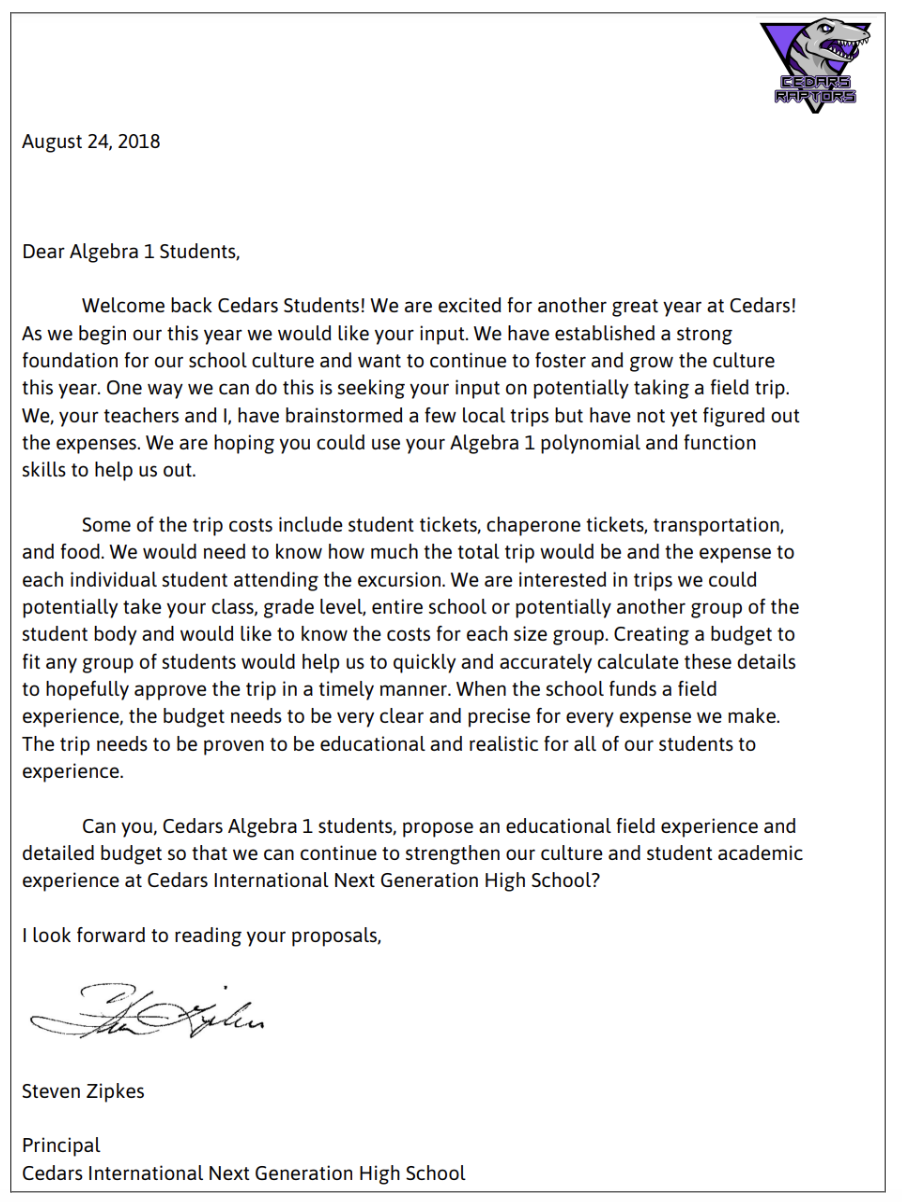
During the entry event, students systematically dissected both the video content and the letter, along with the project rubric, using a protocol known as “knows and need to knows,” a standard practice in PBL classrooms. Through this process, students documented what they already knew about the project and drew upon relevant prior knowledge they deemed valuable for the undertaking. Working individually or in teams, they formulated “Need to Know” questions, drawing inspiration directly from the video, the letter, and the rubric. Additionally, questions arose organically from the students’ creativity as they became immersed in the project. These inquiries were also shaped by the project’s focus statement or driving question, which in this instance was: “We need to understand polynomial and linear equations and be able to communicate a model with precision to an audience in order to persuade the student body and administration to approve our school field trip and budget.”
Checkpoints
Throughout this project, students need to engage in research for all of the expenses needed to go on their field trip of choice (Figure 5). They also need to be able to communicate why the trip is relevant and which group of students this trip is best suited for. Students engage in workshops around research in addition to the mathematics of the unit (Figure 6) to ensure understanding of polynomial and linear questions is built alongside the content. In PBL, students learn the content and additional skills needed to do the work of professionals outside of the classroom walls.
Figure 5
Example research document
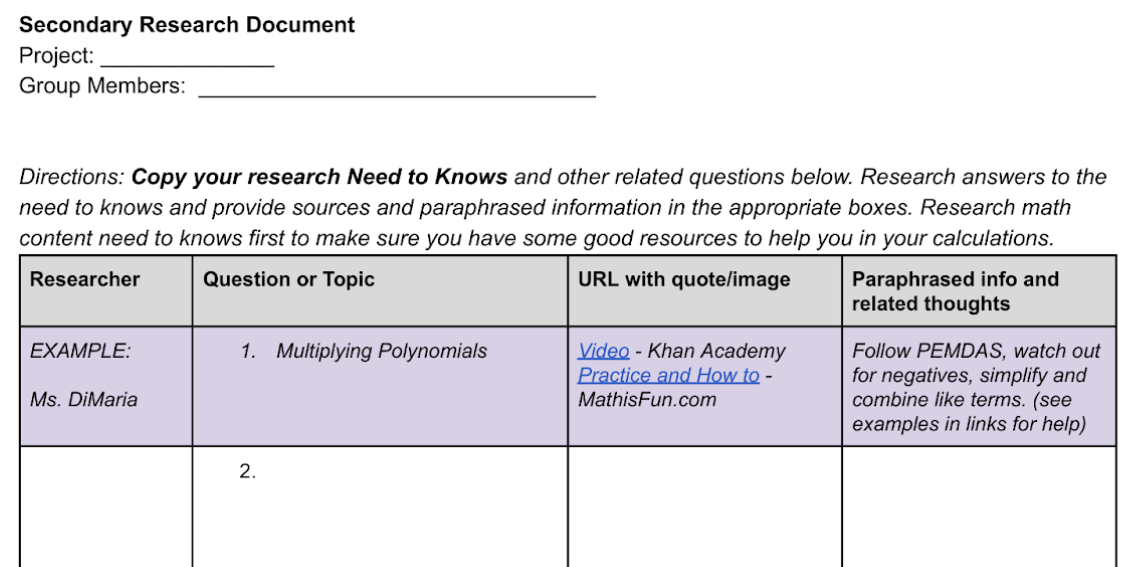
Figure 6
Example from a budget workshop
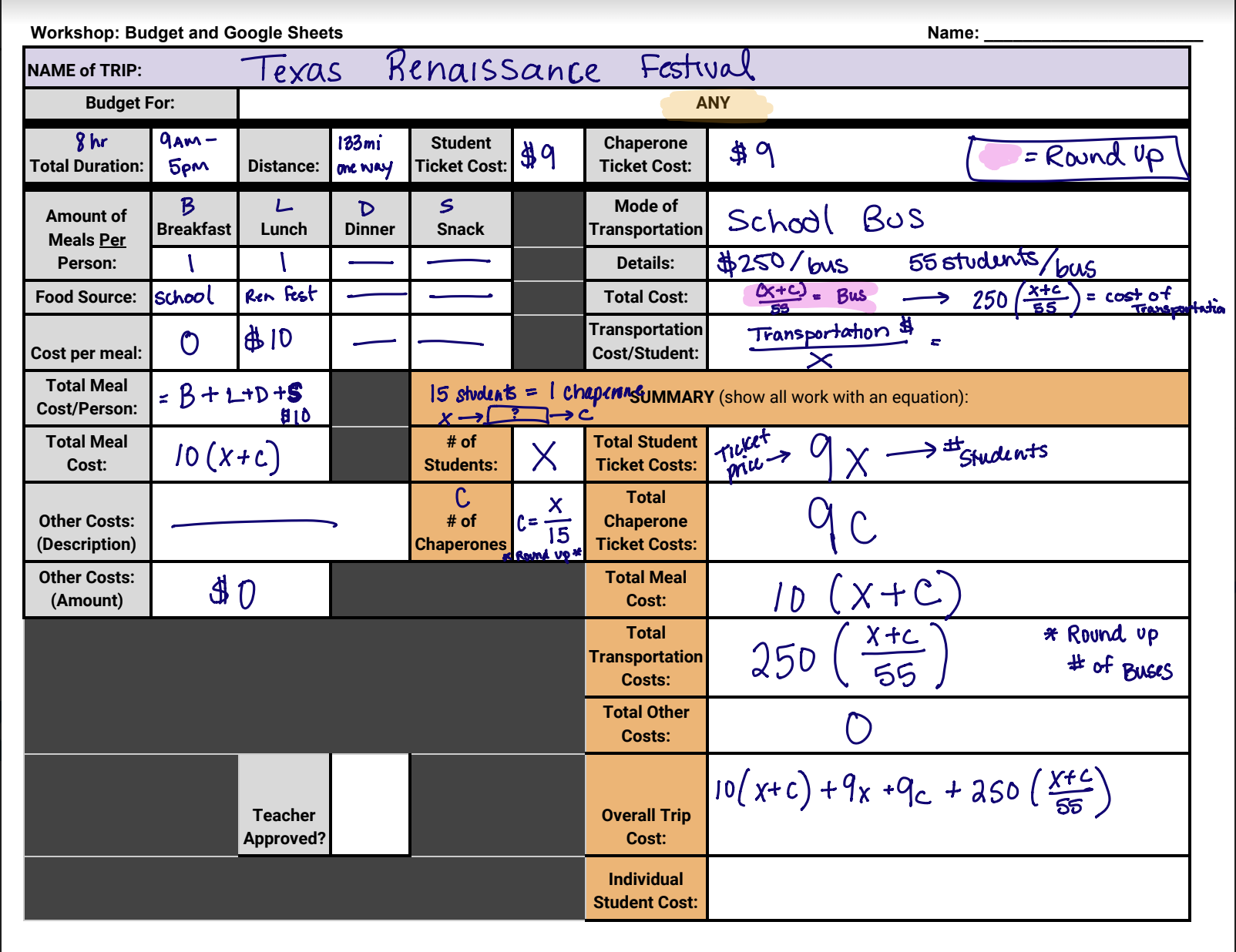
End Product and Presentation
At the culmination of the project students will have individually created: a budget for either their class, their grade level, or the entire student body; collectively created a template for any number of students; written a letter to their principal; and created a presentation for the student council to pitch their idea for a field trip.
When the project was originally launched, the school where Sarah taught had just been established and was looking to start a tradition of yearly field trips for students. One of the groups presented a YMCA culture building trip and now the school welcomes the new 9th graders with a trip to the local YMCA’s high ropes course.
Content Storyline in the Field Trip Project
To develop students’ understanding of polynomials and linear relationships, Sarah engaged in deep analysis of the standards to develop the following content storyline for her project (Figure 7).
Figure 7
Content storyline for Field Trip Project

As you can see within the storyline for this project, Sarah highlighted that she wants her students to be able to write polynomial expressions, perform operations, and create models for real-world scenarios. However, instead of just listing the content standards, the content storyline is written in a manner that connects to and considers the learning projection for students. It gives purpose to the content and would help with answering questions like “Why do we need to learn this” and “What are you working on?”
The implementation of a content storyline through the Field Trip Project planning can be seen through varied components of the learning process. The snapshot of classroom activities (Figure 8), shows a portion of the progression from the beginning to the end of a project and how the content storyline would weave alongside. Through these activities there is an arc of the story of learning within a specific experienced context.
Figure 8
Opportunities for students to showcase and improve their knowledge of the content storyline
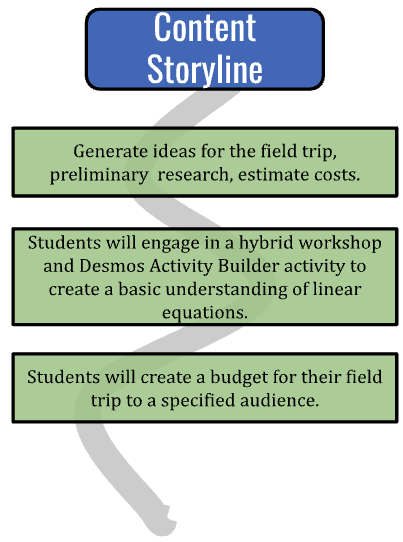
Independently, using a content storyline in classroom planning will lead to deeper content understanding; however, weaving together a consistent content storyline with the elements of PBL and a practice pathway could generate discipline-rich contextualized learning for all.
Practice Pathway in the Field Trip Project
As we consider the Field Trip Project, Sarah had identified attending to precision (National Governors Association, 2010) as the mathematical practice to intentionally scaffold throughout the project. To scaffold this practice, Sarah developed the following practice pathway for her project (Figure 9).
Figure 9
Practice pathway for the Field Trip Project
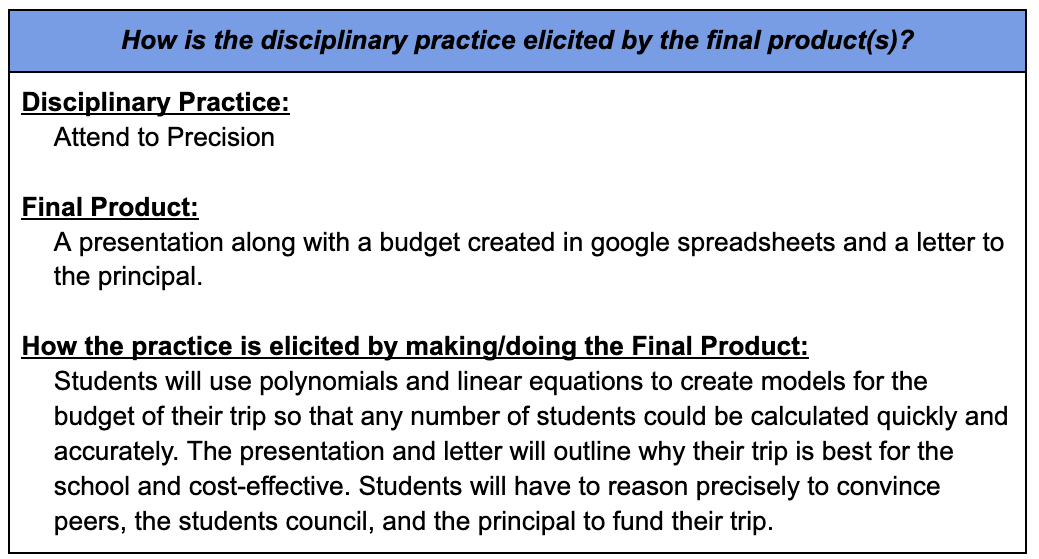
Similar to the content storyline for the Field Trip Project, the practice pathway holds natural connection spaces throughout the learning process of a project. The snapshot of classroom activities (Figure 10) shows again the progression of investing and revisiting the practice pathway from beginning to end of a project. This regular surfacing of the focus practice emphasizes the importance of this learning and skill development to learners.
Figure 10
Opportunities for intentional exposure and feedback on the practice pathway in the Field Trip Project
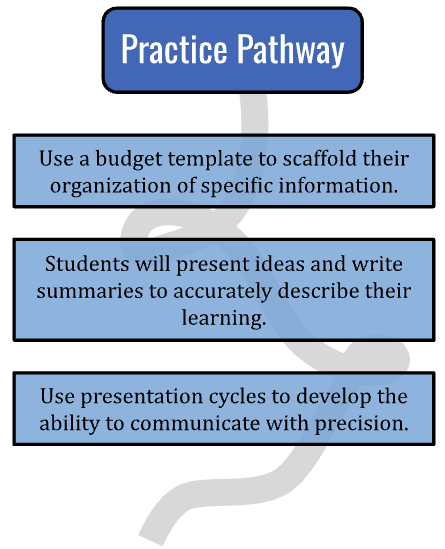
Again, it would be powerful for classroom educators to take up the practice pathway as a core component of lesson planning, but we believe the most rich learning experience for all students would be to engage with the PBL Planning Pyramid as a collective.
Invitations for Future Action
Rather than categorizing PBL as drastically different from other pedagogical practices, we perceive it as a more impactful and meaningful restructuring of classroom dynamics, placing students at the core.
Our journey developing this framework has involved significant learning on how to effectively empower students as owners of their learning process within discipline-rich learning experiences. Rather than categorizing PBL as drastically different from other pedagogical practices, we perceive it as a more impactful and meaningful restructuring of classroom dynamics, placing students at the core. While the prospect of transitioning from traditional instruction to PBL might seem daunting, we recognize those concerns and suggest the following reflective questions or incremental steps:
- How can I integrate a content storyline as a tool to enhance a more cohesive learning experience?
- How can I intentionally center disciplinary practices to foster holistic student learning?
- Identify a unit or set of content standards that currently lacks inspiration.
- Alternatively, consider a unit or set of content standards that could be shaped by student voice and input.
We encourage you to reflect on aspects of your teaching practice where these experiences are already taking place and to expand upon them by incorporating elements of PBL and our PBL Planning Pyramid. We have also developed professional learning experiences to support teachers who are contemplating adopting PBL, which are offered through the Knowles Academy. Two shorter online workshops focus on PBL basics and the PBL planning pyramid (discussed here), and a longer course that equips teachers to develop their own PBL project can be adapted for different contexts. Ultimately, we believe that a solid grasp of math and science empowers individuals to make critical, informed decisions that contribute to personal wellbeing and civic participation. Moreover, discipline-rich, project-based learning offers students intricate learning opportunities.
Citation:
DiMaria, S., Madis, C., Orr, S., Sircar, M.. (2024). STEM Project-Based Learning: Finding balance of content standards, disciplinary practices, and elements of project-based learning. Kaleidoscope: Educator Voices and Perspectives, 11(1). https://knowlesteachers.org/resource/science-and-math-project-based-learning-finding-balance-of-content-standards-disciplinary-practices-and-elements-of-project-based-learning.
